Indexed In
- Open J Gate
- Genamics JournalSeek
- Academic Keys
- ResearchBible
- Cosmos IF
- Access to Global Online Research in Agriculture (AGORA)
- Electronic Journals Library
- RefSeek
- Directory of Research Journal Indexing (DRJI)
- Hamdard University
- EBSCO A-Z
- OCLC- WorldCat
- Scholarsteer
- SWB online catalog
- Virtual Library of Biology (vifabio)
- Publons
- Geneva Foundation for Medical Education and Research
- Euro Pub
- Google Scholar
Useful Links
Share This Page
Journal Flyer

Open Access Journals
- Agri and Aquaculture
- Biochemistry
- Bioinformatics & Systems Biology
- Business & Management
- Chemistry
- Clinical Sciences
- Engineering
- Food & Nutrition
- General Science
- Genetics & Molecular Biology
- Immunology & Microbiology
- Medical Sciences
- Neuroscience & Psychology
- Nursing & Health Care
- Pharmaceutical Sciences
Research Article - (2021) Volume 10, Issue 10
Ethno medicinal Uses of Plants in the Treatment of Pediatrics (Children Diseases) by the Local People of Tehsil Dera Ismial Khan
Riffat Naz1*, Aroosha Malik2, Tehmina Baloch3 and Dr. Samreen Afzal42College of Life Sciences, Nanjing Agricultural University, Nanjing, China
3University of Veterinary and Animal Sciences, Lahore, Pakistan
4College of Life Sciences, Nanjing Agricultural University, Nanjing, China
Received: 06-Oct-2021 Published: 26-Oct-2021, DOI: 10.35248/2168-9881.21.10.232
Abstract
The present research project was carried out during 2005-2008 with the aims to investigate ethno botanical profile, plant diversity and taxonomy of the flora particularly hydrophytes, sedges, grasses and asclepiads of Dera Ismail Khan District. The district is located in the extreme south of the North West Frontier Province (NWFP), Pakistan. The area is gifted with diverse and unique flora, as it is adjacent to the South Waziristan Agency and Suleiman Range in the West, Koh Sheikh Buddin in the North and Indus River in the East. The people are mostly poor and depend on plant resources for their domestic needs. The study was carried out to analyze traditional knowledge of plants resources including local names, habit and habitat, distribution in area, Pakistan, & world, parts used, flowering period, folk medicinal uses, indigenous recipes and other ethno botanical uses, and taxonomic diversity of flora of the area. In this study, in total 434 plant species were recorded. During the study 1 species (1 family) of bryophytes, 4 species (3 families) of pteridophytes, 3 gymnosperms belonging to 2 families and 426 angiosperms belonging to 91 families (17 families of monocots and 74 families of dicots) were collected. Bryophytes constitute 0.23%, pteridophytes 0.92%, gymnosperms 0.69%, monocots 21.1% and dicots 77.06% of total floral biodiversity. Based on the type of usage, the major usage types include medicinal plants 63 species (14.5%), fodder and forage 48 (11.0%), honey bee 85 (19.5%), vegetables and pot herbs 47 (10.8%), fuel wood 59 (13.6%), plants used to make agricultural appliances 13 (3%), edible fruit producing 21 (4.8%), 11 (2.5%) plants used in fencing and hedging and 13 species (3%) for making furniture.
Introduction
Background
Plants are essential biotic component of an ecosystem and are known as autotrophs as they prepare their own food by the process of photosynthesis. Plants are the major source of all energy for ecosystem. Green plants clean and purify the environment by inhalingoxygen and exhalingcarbon dioxide, reducing temperature thus creating healthy effects both physically and physiologically on human beings. Plants being a major component of an ecosystem are necessary for the survival of all living organisms. Planting tree is a Sunnah of Holy Prophet (SAW) and its reward continues even after the death of a person who plants a tree. Raw materials for the preparation of all medicines are obtained from many plants.
The relation of plants, animals and humans is much important. Medicinal plants have been used in the Islamic period for the treatment of various types of illness. Our Holy Prophet (P.B.U.H) used certain herbs for the cure of various diseases. It was stated that 84 percent of Pakistani population was dependent on traditional medicines for their medicinal needs. Medicinal plants are a valuable natural resource and considered as potentially safe drugs. They have been playing an important role in assuaging (comforting) human sufferings by contributing herbal medicines in the primary health care systems. Nearly in every country of the world, through herbs and some traditional medicine system is progressing for treatment. In Indo-Pak. Subcontinent, these traditional systems are called unani or ayurvedic system.
A medicinal plant is a plant which contains substances that can be used for therapeutic purposes or which are precursors for the synthesis of useful drugs. Historically all medicinal preparations were derived from plants, whether in the simple form of plant parts or in the more complex form of crude extracts, mixtures, etc. Medicinal plants have been used by humans from ancient times. Many drugs have plant origin and several plants are currently undergoing investigation to determine their beneficial efficiencies [1]. It is often believed that remedies of natural origins are harmless and carry no risk to the consumer. But this is not the case when toxic plants are used by mistake or where herbal preparations are marketed with the addition of undeclared potentsynthetic substances. The use of manufactured products should be governed by the same standard of safety and efficacy as are required for modern pharmaceutical producers.
There are more than 6,000species of higher plants in Pakistan, of which at least 12 percent are used medicinally. More than 10% of the Pakistani flora (600–700 plant species) is used for medicinal purposes [2]. In developing countries about 4 billion people not only believe in the healing properties of plant species but also use them regularly, as reported by World Health Organization (WHO). It has been estimated that over 80% of the people in developing countries rely on the traditional medicines for their primary health needs.
There are number of diseases common in children worldwide few of them are gastrointestinal, respiratory, urinary, ear, nose, throat infections (ENT), liver, kidney disorders, eye infections and dental anomalies etc. First preference of people especially in rural areas is to cure these illness using medicinal plants either in raw or in processed form Pakistan is enriched with medicinal herbs growing in wild. Most of these plants have prodigious medicinal value, often only known to indigenous communities. With rapid urbanization of forests and hills, the rich herbal wealth of our country is fast dwindling [3]. Since long the natives of the area have always been using medicinal plants for several diseases and depend on the surrounding plant resources. The people of the area are very much close to natural vegetation. Women of the area participate actively in the preparation of herbal medicines from the plants which they collect from fields either by themselves or by their men and children. The area has not so far been explored ethno botanically so a survey was considered necessary in above respect to enlist the local plant species, their parts used and their medicinal uses to document such information in the district of Dera Ismial Khan
Materials and Methods
Materials
During the survey following material is used;
Pencil, Notebook, Digital camera and questionnaire etc.
Study Area
Dera Ismial Khan district has rich flora of medicinal, aquatic and other useful plants, that’s why this area is selected for the study. The study was conducted during September 2018 to May 2019. For data collection following areas of city D.I.Khan was surveyed such as Muryali, Deenpoor, nayichungi, Tosifabad, Zaffarabadcolny, commissionrcolony, Madina colony, Indus colony, Bastidewala, Gelani town, Qureshimorr, Neemwaligali, Baghwaligali, chaa peepal and nawab etc. In these areas major plants used for medicinal purposes were found.
Method
Frequent visits were arranged in order to collect information about the folk/culinary knowledge of medicinal plants used by the local people of Dera Ismail Khan, District. Questionnaire was designed in English to collect ethno medicinal knowledge of medicinal plants used against children diseases. The interview was carried out in various area of district D.I.Khan. Informants were firstly introduced briefly with the aim of the study. Interviews were taken from local females of different ages in homes about various medicinal plants. The data was collected in local languages such as Saraiki, Pashto, Urdu and was translated into English. Data on informants demography, medicinal plants local name, botanical name, part used, ingredients, disease/conditions treated, method of preparation , mode of utilization and route of administration was recorded.
During the current study a total of 52 plant species and their medicinal uses were collected belonging to 34 families and 46genera by surveying the above discussed areas. Out of 34 families the dominant family with highest number of medicinal plants were Apiaceae, and Solanaceae, (4 species) followed by Fabaceae, Poaceae and Zingeberaceae (3 species), Alliaceae, Oleaceae, Plantaginaceae, Rosaceae, Myretaceae (2 Species) and remaining 24families were represented by 1 species each. The data has arranged alphabetically on the basis of disease name. Ingredients are mentioned and remedies preparation methods are also written down. The photographs of the plants which are used in these herbal remedies have also been taken. Data was collected by using the following questionnaire.
Results
Total 60 interviews including 55 females and 5 males were conducted in the present study for children diseases. Children disorders information’s are mostly confined to women in the study area. The present study provides information of ethno medicinal uses of 52 plants belonging to 34 family and 46 genera. All the identified species and their ethno botanical information are elucidated. Out of 34 families the dominant family with highest number of medicinal plants were Apiaceae, and Solanaceae, (4 species) followed by Fabaceae, Poaceaeand Zingeberaceae (3species), Alliaceae, Oleaceae, Plantaginaceae, Rosaceae, Myrtaceae (2 Species) and remaining 24families were represented by 1 species each. Different parts of medicinal plants are used as medicine by the local peoples (Figure 4.2). Among the different plant parts, the Seeds (25.5%) and fruit (23.5%) are most frequently used for the treatment of diseases followed by whole plant and flower (9.8% each), leaves (7.9%), roots (5.9%), oil and rhizome (3.9%), bulb, scales, bark, stem, and peel(1.9% each respectively ). The recipes on children diseases were arranged in alphabetic order of botanical name followed by, family, local name, disease name, part used, ingredients and recipe and action which are further described as follow.
Allium SativumL
Family: Alliaceae
Local name: Garlic (E), Lehsan (U), Ozha (P)
Disease name: Ear ache
Ingredients: Garlic 20-30 bulb lets and mustard oil
Recipe and action: 20-30 bulb lets are fried in 500ml of mustard oil for 20 minutes and this oil is filtered with the help of a cloth. The filtered oil is stored in a bottle and 2-3 drops are used in case of ear aches. This remedy is useful in providing relief from ear ache (Figure 1).
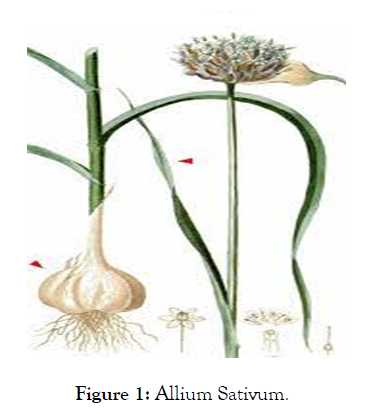
Figure 1: Allium Sativum.
Azadirachta Indica
Family: Meliaceae
Local name: Neem
Disease name: Skin itching (Allergy)
Part used: Leaves
Ingredients: Leaves and water
Recipe and action: Neem leaves are boiled in water. Decoction is then used for bathing. This phytotherapy is effective in providing relief from itching and is useful for children of all ages (Figure 2).
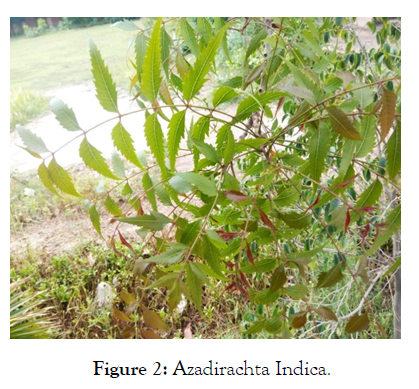
Figure 2: Azadirachta Indica.
Amaranth us viridisL
Family: Amaranthaceae
Local name: Prince Feathers (E), Chaulai (S).
Disease name: Pneumonia
Part used: Roots
Ingredients: Roots extract
Recipe and action: Extract of fresh root about 5ml is given to the children thrice a day. This remedy is useful for the treatment of pneumonia (Figure 3).
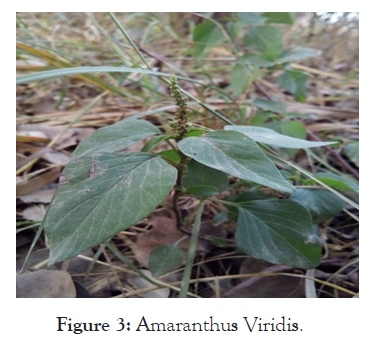
Figure 3: Amaranthus Viridis.
Allium cepa L.
Family: Alliaceae
Local name: Onion (E), Piyaz (U)
Disease name: Cholera
Part used: Scales
Recipe and action: Scales of onion are crushed properly. Extract of these scales are then given to the children. This remedy is effective in treating cholera (Figure 4).
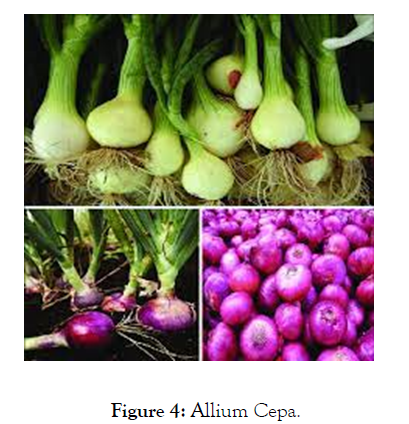
Figure 4: Allium Cepa.
Amomumsubulatum Rox b.
Family: Zingiberacee
Local name: Bari eliachi (U), Black cardamom (E)
Disease name: Dry cough
Part used: Fruit
Ingredients: Black cardamom and lump sugar
Recipe and Action: The above ingredients are grinded well to make a fine powder. A pinch of this powder is given to the children of age more than two years twice a day. An effective remedy for dry cough (Figure 5).
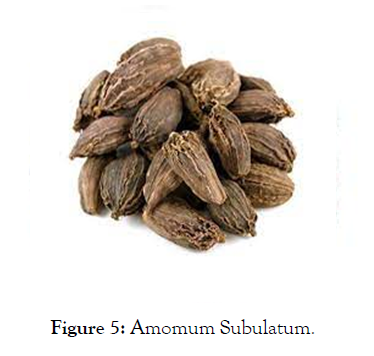
Figure 5: Amomum Subulatum.
Brassica compestris
Family: Brassicaceae
Local name: Sarson (U), Mustard (E)
Disease name: Nasal congestion
Plant parts used: Seeds (oil)
Recipe and action: Mustard oil is heated. This heated oil is then smelled by child for opening of nasals. This recipe is useful for children of all ages. It is effective for Congested nasals (Figure 6).
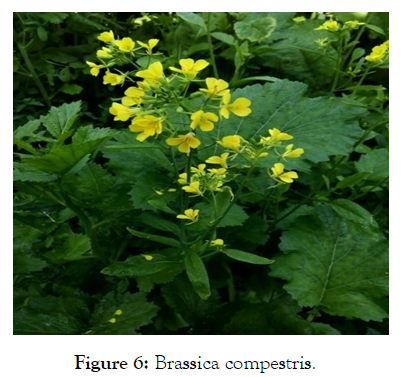
Figure 6: Brassica compestris.
Calotropisprocera (Aiton) W.TAiton
Family: Asclepiadaceae
Local name: Aak (S), spalmaka (P)
Parts used: Androecium and gynoecium
Disease: Jaundice
Ingredients: Butter, dried androecium and gynoecium
Recipe and action: Dried parts of flower are crushed and this powder is mixed with butter. Now this mixture is given to the patient daily in the morning. This remedy is helpful in jaundice.
Recipe#2:
Disease: Boils disease
Recipe and action: Calotropis latex is proved to be effective for boils disease in children. Latex of Calotropis is applied over the infected areatwiceaday. This remedy is effective and provides relief from this disease (Figure 7).
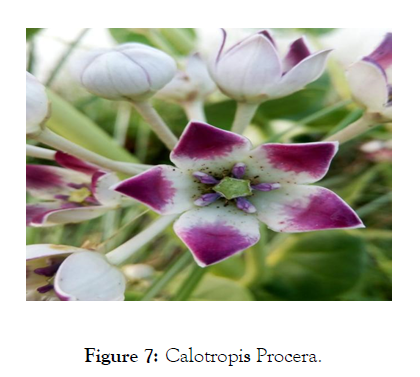
Figure 7: Calotropis Procera.
Cycasrevolute Thunb.
Family: Cycadaceae
Local name: Sagodana (U), Sagu seeds (E)
Disease: Typhoid
Parts used: Seeds
Ingredients: Sagu seeds, milk, grapes, dates
Recipe and Action: 4 table spoon of sagu seeds, some dried grapes and dates are boiled in 250mlof milk. When the solution becomes somewhat dense it is now ready to use and is given to the patient until relief.
Recipe#2
Disease: Measles
Plant parts used: Seeds
Ingredients: Sagu seeds milk and dried dates (Chohara).
Recipe and Action: Sagu seeds and dried dates are boiled in the milk properly. It is a remedy for children suffering from measles (Figure 8).
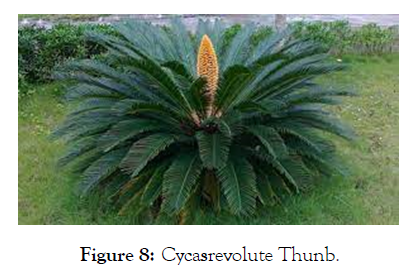
Figure 8: Cycasrevolute Thunb.
Coriandrumsativum L.
Family: Apiaceae
Local Name: Coriander (E), Dhaniya (U)
Disease Name: Dry cough
Plant parts used: Seeds
Ingredients: Milk and coriander seeds
Recipe and Action: Coriander is boiled in the milk. Decoction is given to children for dry cough (Figure 9).
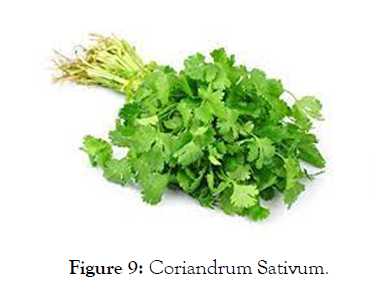
Figure 9: Coriandrum Sativum.
Cinnamomumverum
Family: Lauraceae
Local name: Daarcheeni (U)
Disease: Cough
Parts used: Bark
Ingredients: Cinnamomumverum (Daarcheeni) and Amomumsubulatum (black cardamom)
Recipe and Action: Black Cardamom and Cinnamomumverumare grinded together. Half tea spoon of this powder is given to the children. This remedy is effective and provides relief from cough (Figure 10).
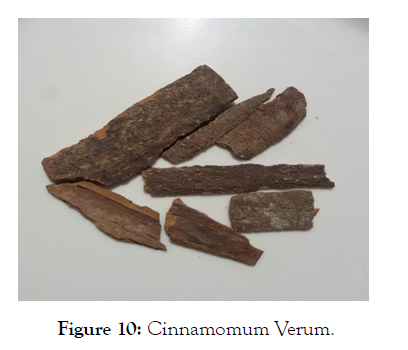
Figure 10: Cinnamomum Verum.
Cassiaabsus
Family: Fabaceae
Local name: Chaksu (U)
Disease: Diarrhea
Part used: Seeds
Ingredients: Seeds powder and butter
Recipe and action: One tea spoon of butter and 2 tea spoon of seed powder are mixed with each other. This paste is given to the children an effective remedy for diarrhea.
Recipe#2:
Disease: Reddish spots on the body (Allergy)
Parts used: Chaksu seeds and kachoor
Ingredients: Chaksu seeds, kachoor and mother milk.
Recipe and Action: Chaksu and kachoor are grinded to make a powder. This powder is filtered and is mixed with small amount of mother milk. The paste is given to the infants of age more than 40 days and is effective in relieving abdominal pain and allergy (Red spots on body) (Figure 11).
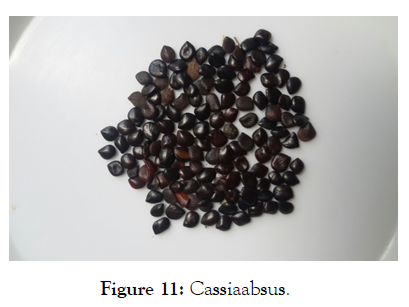
Figure 11: Cassiaabsus.
ConvolvulusarvensisL.
Family: Convolvulaceae
Local Name: Morning glory, Bind weeds, Wanweri (S).
Disease Name: Abdominal pain
Part used: Leaves and branches
Recipe and Action: Whole plant except root is cooked just like vegetable. This recipe is used for abdominal pain in children.
Recipe#2
Disease Name: Worms
Plant Parts used: Leaves
Recipe and Action: The whole plant is cooked as vegetable and is given to the children for worms complaints (Figure 12).
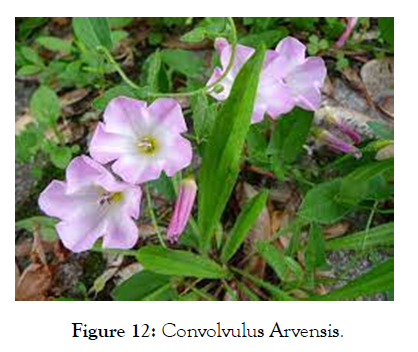
Figure 12: Convolvulus Arvensis.
Cymbopoganjwarancusa (Jones)Schult
Family: Poaceae
Local Name: Khavi
Disease: Chicken pox
Part used: Whole plant
Ingredients: Whole plant only
Recipe and Action: The dried plant is placed over cinders. The children having chicken pox are exposed to the smoke of that plant. This remedy is used daily until relief (Figure 13).
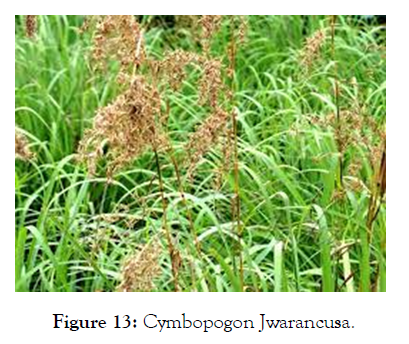
Figure 13: Cymbopogon Jwarancusa.
Cassia fistula
Family: Fabaceae
Local name: Amaltas (U), Golden shower (E), Gard nail (P)
Disease: Abdominal pain and cleaning
Part used: Seeds
Ingredients: Fennel (arq), amaltas seeds
Recipe and Action: Few seeds of amaltas are boiled in fennel arq. Few drops of it are given to the children for abdominal pain. It is given to infants from the very first day for cleaning their abdomen and also effective for abdominal pain (Figure 14).
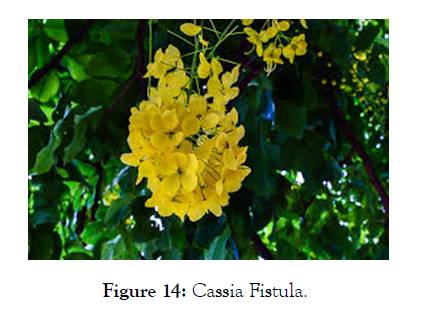
Figure 14: Cassia Fistula.
Conclusion
Medicinal plants are playing a vital role in traditional medicines. In present study, precious data regarding traditional medicinal knowledge of local people has been documented which consist of 52 plants belonging to 34 family and 45genera. Colic pain, Diarrhea, Ear ache and measles are most common diseases that are treated by medicinal plants recipes. Despite having modern health care facilities available in the study area but the local community still rely on herbal remedies. The chances of loss of traditional knowledge from the human community are always present due to reduction of natural resources and modernization of the society. So, it is necessary to document this worth traditional knowledge of the natural wealth. It is concluded that, future antimicrobial, anti-viral, and pharmacological investigations are required on the pharmacological efficacy of various ethno medicines used by them. The medicated claims incorporated in the study need to be evaluated through phytochemical and pharmacological investigations to discover their potentiality as drugs and to ratify the efficacy and safety of the medicinal plant species.
REFERENCES
- Adeogun, Oluwagbenga. Survey and Phytochemical Analyses of Plants Use for the Treatment of Childhood Diseases in OjoLga, Lagos State. Int J Herb Med. 2014; 2: 109-114.
- Ahmadipour, Saeedeh, Mohsenzadeh A, Asadi-Samani, Majid. The importance of some native medicinal plants of Iran effective on gastrointestinal disorders in children: A review. 2016; 8: 61-66.
- Ahmadipour, Saeedeh, Mohsenzadeh A, Eftekhari, Zohre. An overview of the most important medicinal plants affecting on child's jaundice in ethnobotanical resource of Iran. 2016; 8:135-139.
Citation: Naz R, Malik A, Baloch T, Afzal S (2021) Ethno medicinal Uses of Plants in the Treatment of Pediatrics (Children Diseases) by the Local People of Tehsil Dera Ismial Khan. Agrotechnology 10: 232. doi: 10.35248/2168-9881.21.10.232.
Copyright: © 2021 Naz R, et al. This is an open-access article distributed under the terms of the Creative Commons Attribution License, which permits unrestricted use, distribution, and reproduction in any medium, provided the original author and source are credited.


